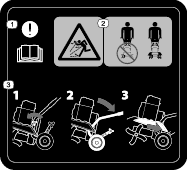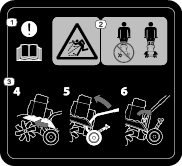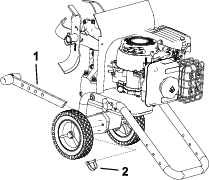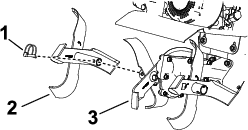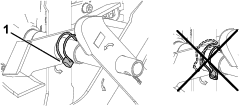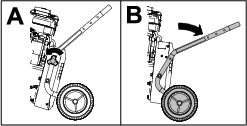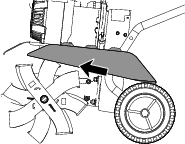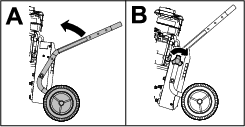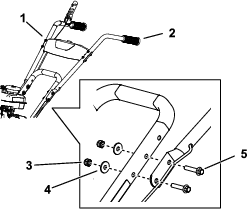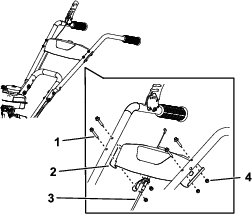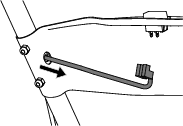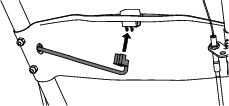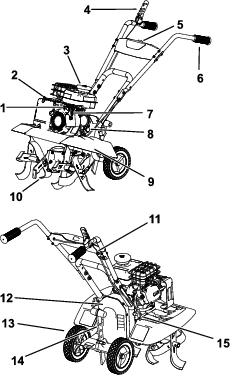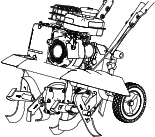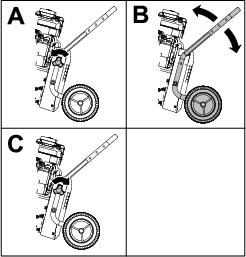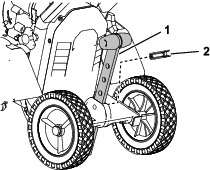Maintenance
Maintenance Safety
-
Inspect the machine frequently to ensure that it is in safe working condition and that shear bolts, engine-mounting bolts, and other fasteners are properly tightened.
-
Shut off the machine and wait for all moving parts to stop before you leave the operator’s position. Disconnect the spark-plug wire, keep it away from the plug to prevent accidental starting, and allow the machine to cool before adjusting, fueling, unclogging, servicing, cleaning, or storing the machine.
-
Wear gloves and eye protection when servicing the machine.
-
Never tamper with safety devices. Check their proper operation regularly.
-
To ensure optimum performance of the machine, use only genuine Toro replacement parts and accessories. Replacement parts and accessories made by other manufacturers could be dangerous, and such use could void the product warranty.
-
Replace tines that are bent, damaged, or loose; do not repair or alter them.
-
Keep the machine, attachments, and accessories in safe working condition.
-
Do not attempt to repair the machine unless you have the proper tools and instructions for disassembling, assembling, and repairing the machine.
Recommended Maintenance Schedule(s)
| Maintenance Service Interval | Maintenance Procedure |
|---|---|
| After the first 20 hours |
|
| Before each use or daily |
|
| Every 25 hours |
|
| Every 50 hours |
|
Pre-Maintenance Procedures
Preparing for Maintenance
-
Move the machine to a level surface, shut off the engine, and wait for all moving parts to stop.
-
Disconnect the spark-plug wire from the spark plug.
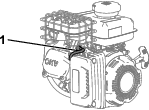
-
After performing the maintenance procedure(s), connect the spark-plug wire to the spark plug.
Important: Before tipping the machine to replace the blade, allow the fuel tank to run dry through normal usage. If you must tip the machine prior to running out of fuel, use a hand fuel pump to remove the fuel.
Engine Maintenance
Servicing the Air Cleaner
| Maintenance Service Interval | Maintenance Procedure |
|---|---|
| Every 25 hours |
|
-
Refer to Preparing for Maintenance.
-
Remove the air-cleaner cover.
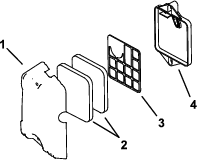
-
Remove and inspect the air-cleaner elements.
-
Inspect the air-cleaner elements.
-
Replace any torn or worn element. Otherwise, clean each element as follows:
-
Wash the element with warm water and a mild detergent.
Important: Press the element when washing it; do not twist it.
-
Dry the element by pressing it in a clean cloth.
-
Thoroughly oil the foam element using new engine oil and press out any excess oil.
-
-
Install the elements, screen, and air-cleaner cover to the base.
Servicing the Engine Oil
Engine-Oil Specifications
| Engine oil capacity | 0.35 L (11.8 fl oz) |
| Oil viscosity | Refer to the chart below. |
| API service classification | SJ or higher |
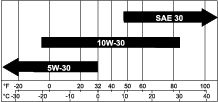
Important: Do not use SAE 10W-40 Motor Oil.
Checking the Engine-Oil Level
| Maintenance Service Interval | Maintenance Procedure |
|---|---|
| Before each use or daily |
|
-
Move the machine to a level surface.
-
Remove the dipstick.

-
Wipe the dipstick clean with a clean cloth.
-
Insert the dipstick into the oil-fill tube and tighten it.
-
Remove the dipstick and check the engine-oil level.
-
If the oil level is low, slowly add oil into the filler tube until the level is at the top thread of the tube.
-
Insert the dipstick into the oil-fill tube and tighten it.
Changing the Engine Oil
| Maintenance Service Interval | Maintenance Procedure |
|---|---|
| After the first 20 hours |
|
| Every 25 hours |
|
| Every 50 hours |
|
Note: Run the engine a few minutes before changing the oil to warm it. Warm oil flows better and carries more contaminants.
-
Move the machine to a level surface.
-
Refer to Preparing for Maintenance.
-
Place a pan under the drain plug to catch the oil.
-
Remove the oil-fill plug and allow the oil to drain.
Note: Dispose of the used oil at a certified recycling center.

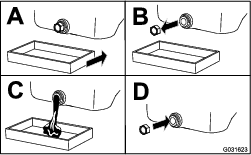
-
Install the oil-fill plug.
-
Slowly pour oil into the oil-fill hole until the oil is at the correct level; refer to Engine-Oil Specifications.
-
Ensure that the oil is at the correct level on the dipstick; refer to Checking the Engine-Oil Level.
-
Wipe up any spilled oil.
Servicing the Spark Plug
| Maintenance Service Interval | Maintenance Procedure |
|---|---|
| Every 50 hours |
|
Ensure that the air gap between the center and side electrodes is correct before installing the spark plug.
Use a spark plug wrench for removing and installing the spark plug(s) and a gapping tool/feeler gauge to check and adjust the air gap. Install a new spark plug(s) if necessary.
Type: LG E5RTC
Air gap: 0.75 mm (0.03 inch)
Removing the Spark Plug
-
Disconnect the spark-plug wire from the spark plug.

-
Clean around the spark plugs to prevent dirt from entering the engine and potentially causing damage.
-
Remove the spark plug.
Checking the Spark Plug
Important: Do not clean the spark plug(s). Always replace the spark plug(s) when it has a black coating, worn electrodes, an oily film, or cracks.
If you see light brown or gray on the insulator, the engine is operating properly. A black coating on the insulator usually means the air cleaner is dirty.
Set the gap to 0.75 mm (0.03 inch).
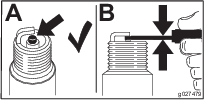
Installing the Spark Plug
-
Thread the spark plug clockwise into the spark-plug hole by hand.
-
Rotate the spark plug clockwise using a spark-plug wrench until the plug and sealing washer are seated.
-
Tighten the spark plug as follows:
-
When installing the original spark plug, tighten the plug an additional 1/2 turn.
-
When installing a new spark plug, tighten the plug an additional 1/8 to 1/4 turn.
Important: A loose spark plug may cause the cylinder to overheat. An over-tight spark plug may damage the threads in the cylinder head.
-
-
Connect the spark-plug wire to the spark plug.
Fuel System Maintenance
Danger
In certain conditions, fuel is extremely flammable and highly explosive. A fire or explosion from fuel can burn you and others and can damage property.
Refer to Fuel Safety for a complete list of fuel related precautions.
Servicing the Fuel Filter
-
Refer to Preparing for Maintenance.
-
Drain fuel from the fuel tank.
-
Remove the 2 nuts securing the muffler to the engine and remove the muffler.
-
Remove the 3 bolts securing the fuel-tank assembly to the engine.
-
Gently lift the fuel tank off the engine. Loosen the hose clamp and disconnect the hose from the filter.

-
Remove the filter by using a socket to turn it counterclockwise.
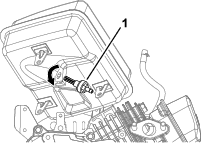
-
Clean the filter using kerosene or a similar solvent.
Note: Replace the filter if it is extremely dirty or torn.
-
Install the filter by using a socket to turn it clockwise.
-
Connect the hose to the filter and secure it using the hose clamp.
-
Install the fuel tank and secure it using the 3 bolts previously removed.
-
Install the muffler and secure it using the 2 bolts previously removed.
-
Add fresh fuel to the engine. Check for leaks before starting the engine.
Belt Maintenance
Checking and Adjusting the Belt Tension
| Maintenance Service Interval | Maintenance Procedure |
|---|
The belt tension may decrease over time. You may need to adjust the belt within the first half hour of operation.
Important: Check the belt tension regularly. Improper belt tension may cause premature belt wear.
-
Remove the pulley cover.
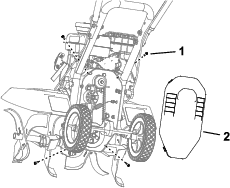
-
With the drive-control lever in the neutral position, measure the length of the relaxed cable spring.
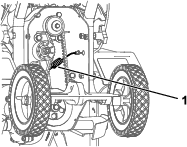
-
Pull down the drive-control lever and measure the length of the extended cable spring. The difference should be 0.32 to 0.6 cm (1/8 to 1/4 inch).
-
If the belt needs adjustment, hold the lower jam nut in place and adjust the upper jam nut in 0.32 cm (1/8 inch) increments. Check the tension again, and repeat as necessary.
Note: If the tension is incorrect and you cannot adjust the jam nuts further, move the Z-bend end of the cable to the next hole in the drive-control lever as shown in Figure 37. If the tension is still incorrect, replace the belt.


-
Tighten the lower jam nut.
-
Install the pulley cover.
Replacing the Drive Belt
| Maintenance Service Interval | Maintenance Procedure |
|---|---|
| Every 50 hours |
|
Removing the Belt
-
Remove the pulley cover.

-
Gently pull the engine recoil rope to rotate the pulley.
-
While the pulley turns, force the belt out of the groove.
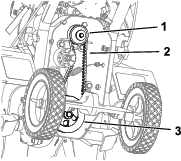
-
Slide the belt off the engine pulley.
-
Pull the belt down and out of the way.
-
Push the belt down and away from the transmission pulley to remove it.
Installing the Belt
-
Place belt in the transmission pulley groove.

-
Gently pull the engine recoil rope to rotate the engine pulley while forcing the belt into the groove.
-
Check the belt tension; adjust it as necessary.
-
Install the pulley cover.

Cleaning
Cleaning the Tine Axle Shaft
| Maintenance Service Interval | Maintenance Procedure |
|---|
Remove all vegetation, string, wire, and other material that may have accumulated on the axle between the inner tines and the transmission housing.
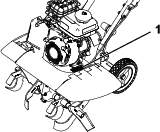

 , which means
Caution, Warning, or Danger—personal safety instruction. Failure
to comply with these instructions may result in personal injury or
death.
, which means
Caution, Warning, or Danger—personal safety instruction. Failure
to comply with these instructions may result in personal injury or
death.



